Key takeaways:
- Diverse perspectives in group brainstorming spark innovative solutions and foster a sense of joint ownership, enhancing commitment to project success.
- Creating a safe and collaborative environment with structured techniques, such as round-robin sharing and mind mapping, encourages participation and idea generation.
- Post-session evaluation, effective follow-up, and feedback loops are crucial for refining ideas and strengthening team dynamics, leading to successful implementation of concepts.
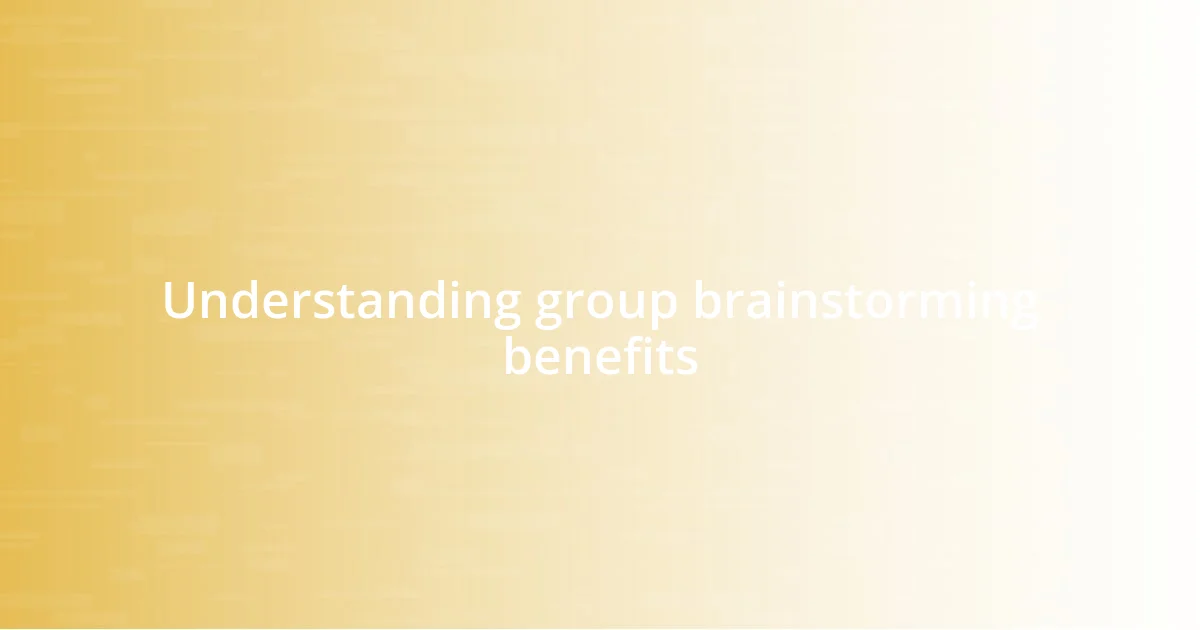
Understanding group brainstorming benefits
One of the most profound benefits of group brainstorming is the diverse perspectives that emerge. I remember a time when a team I was part of faced a particularly challenging project. As we exchanged ideas, it became clear that each person brought a unique viewpoint, and those differences sparked solutions that none of us would have considered alone. It’s fascinating to witness how one suggestion can morph into something entirely new with input from different minds.
Additionally, the collaborative environment of group brainstorming fosters a sense of belonging and teamwork. I’ve felt an electric energy in the room when ideas flow freely, and I can’t help but ask, doesn’t that motivation ignite our passion for creativity? It’s in those moments of shared enthusiasm that I find the group dynamic elevates the quality of the ideas, making the whole experience not just productive but also enjoyable.
Moreover, brainstorming together often leads to greater commitment to the chosen ideas. I’ve seen how when people contribute, they feel a personal stake in the outcome, which drives them to follow through and support the project’s success. Isn’t it interesting to think about how collective ownership can transform a simple idea into a powerful plan of action? This sense of joint responsibility can truly propel a project forward in ways that individual brainstorming simply can’t match.

Key elements of effective brainstorming
Effective brainstorming thrives on creating a safe space for everyone involved. In my experience, when participants feel comfortable sharing even the wildest ideas, the creativity just flows. I recall a session where we encouraged everyone to present their ideas without judgment. The result? A dizzying array of concepts that transformed into a robust plan; it’s exhilarating to witness the magic that occurs when people feel free to express themselves.
Here are some key elements to consider for effective brainstorming:
- Encouragement of All Ideas: Every suggestion, no matter how unconventional, is welcomed.
- Respectful Listening: Active listening ensures that everyone feels valued, which fosters more engagement.
- Clear Focus on Objectives: Keeping the group centered on the main goal prevents drifting into irrelevant discussions.
- No Criticism During Idea Generation: This rule helps maintain an open environment where creativity can flourish.
- Building on Others’ Ideas: Collaboration often leads to enhanced solutions that surpass individual contributions.
With these elements in play, the brainstorming experience becomes not just about generating ideas but also about building relationships and trust among team members—something I find deeply rewarding.
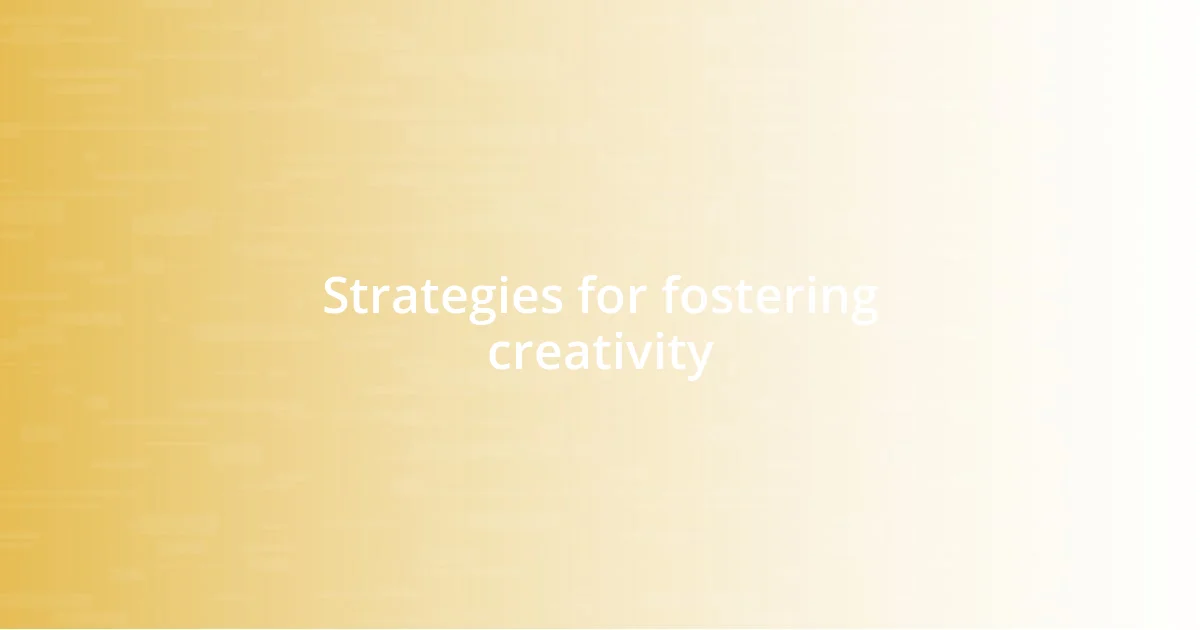
Strategies for fostering creativity
Fostering creativity in group brainstorming relies heavily on structured approaches that invite participation from everyone. One effective strategy I’ve found is incorporating activities like icebreakers or warm-up exercises at the start of the session. This not only relaxes participants but also sparks fresh ideas early on. I once led a session where we played a game that involved word association, and it surprisingly broke down barriers. The laughter and playful competition opened up the room, paving the way for a flood of innovative thoughts that followed.
Another powerful technique is to implement brainstorming techniques such as mind mapping or the “six thinking hats” method. These approaches encourage different types of thinking, allowing group members to explore issues from various angles. I’ve experienced mind mapping transforming abstract concepts into concrete ideas that everyone could visualize. It was like connecting the dots where each person’s input added depth to our shared understanding. Suddenly, we moved from simply generating ideas to creating an intricate tapestry of solutions that felt both comprehensive and cohesive.
Ultimately, establishing a clear goal for the brainstorming session can direct creativity. In one project, we segmented our discussion into phases, where each phase focused on a specific aspect of the problem. This clarity transformed our ideas from scattered thoughts into actionable steps. By the end, we not only had a robust plan but also a renewed sense of purpose. It reminded me how guiding creativity through structure can yield phenomenal results.
| Strategy | Description |
|---|---|
| Icebreakers | Activities at the start that relax participants and stimulate early ideas. |
| Mind Mapping | Visual technique that connects ideas and fosters comprehensive discussion. |
| Clear Goals | Establishing specific objectives to focus the creative output. |

Techniques for encouraging participation
One of the techniques I’ve found invaluable for encouraging participation is the practice of round-robin sharing. Picture this: everyone in the group goes around the table, taking turns sharing one idea each. I remember a particularly engaging session where this approach opened the door for quieter members to express themselves. There’s something powerful about the simplicity of this method; it ensures everyone gets a voice, and I’ve seen how it can break the silence that sometimes lingers in a brainstorming room. Isn’t it fascinating how a structured turn can unleash a wave of creativity?
Incorporating visual aids, like sticky notes or whiteboards, can also significantly boost participation. During one brainstorming workshop I led, we tackled a complex problem using a large whiteboard where participants could jot down thoughts and rearrange them freely. The energy in the room was palpable—people moved around, engaged with each other’s contributions, and began to build on ideas visually. This tactile element not only made concepts more accessible but also ignited conversations that wouldn’t have happened otherwise. How often do we underestimate the power of the visual in sparking collaboration?
Lastly, creating small breakout groups can really elevate participation levels. I remember a time when our main session felt almost too large and overwhelming. By splitting into smaller teams, we were able to dive deeper into specific ideas, and the resultant discussions were rich and vibrant. The intimacy of those smaller settings allowed for more personal connections and, ultimately, a greater sense of ownership over the ideas generated. Doesn’t it make you wonder how much more we could achieve if we shifted our focus to making everyone feel like a key player?
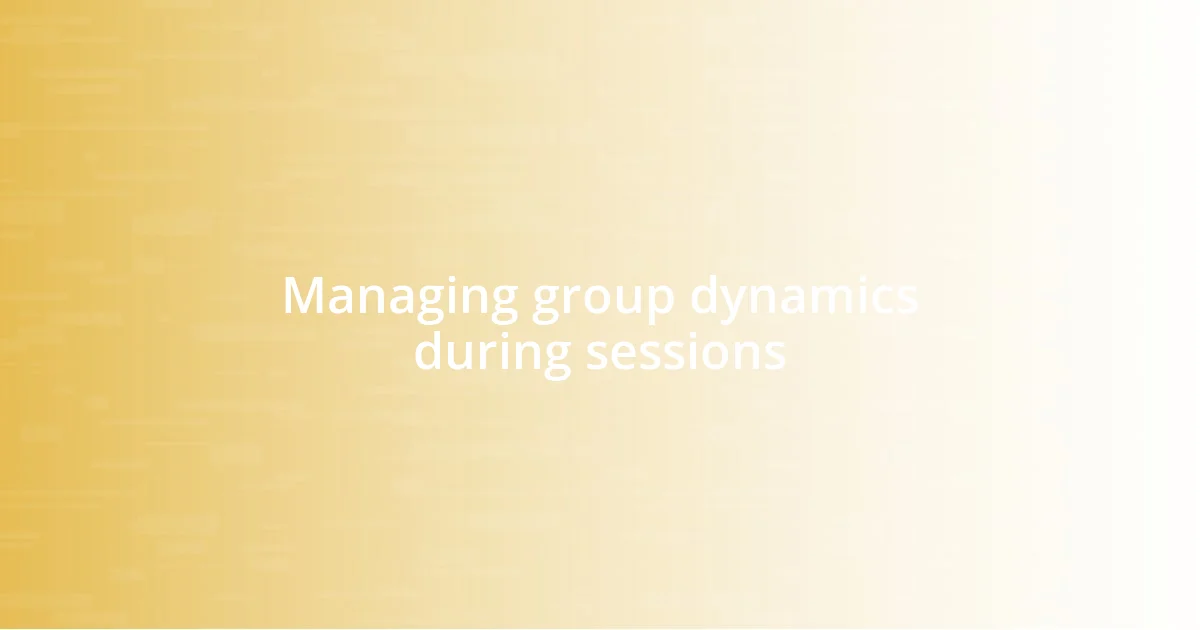
Managing group dynamics during sessions
Managing group dynamics during brainstorming sessions can be quite the balancing act. I’ve found that being aware of the group’s energy is essential. For instance, in a session where I sensed a lull, I decided to shake things up by introducing a quick, energizing game. The shift in atmosphere was remarkable—a hopeless situation turned into an interactive moment where laughter and excitement paved the way for an outburst of creativity. Have you ever seen how a simple change can reignite a room?
It’s also vital to recognize and address dominant voices in the group. I remember a brainstorming meeting where one person’s enthusiasm overshadowed others. To counter this, I gently interjected and asked quieter members to share their thoughts. It was enlightening to see how their insights often brought in unique perspectives that radically shifted our approach. Why is it that sometimes we overlook the quieter voices? Making space for everyone can unlock hidden gems of creativity.
Lastly, establishing a culture of trust within the group can change everything. During one project, we spent a few moments sharing personal anecdotes related to our brainstorming topic. This vulnerability created a strong bond among us, encouraging people to take risks with their ideas. The shift in dynamic was powerful; suddenly, participants felt safe to voice even the most outlandish thoughts. Isn’t it fascinating how connection can elevate creativity and inspire innovation?
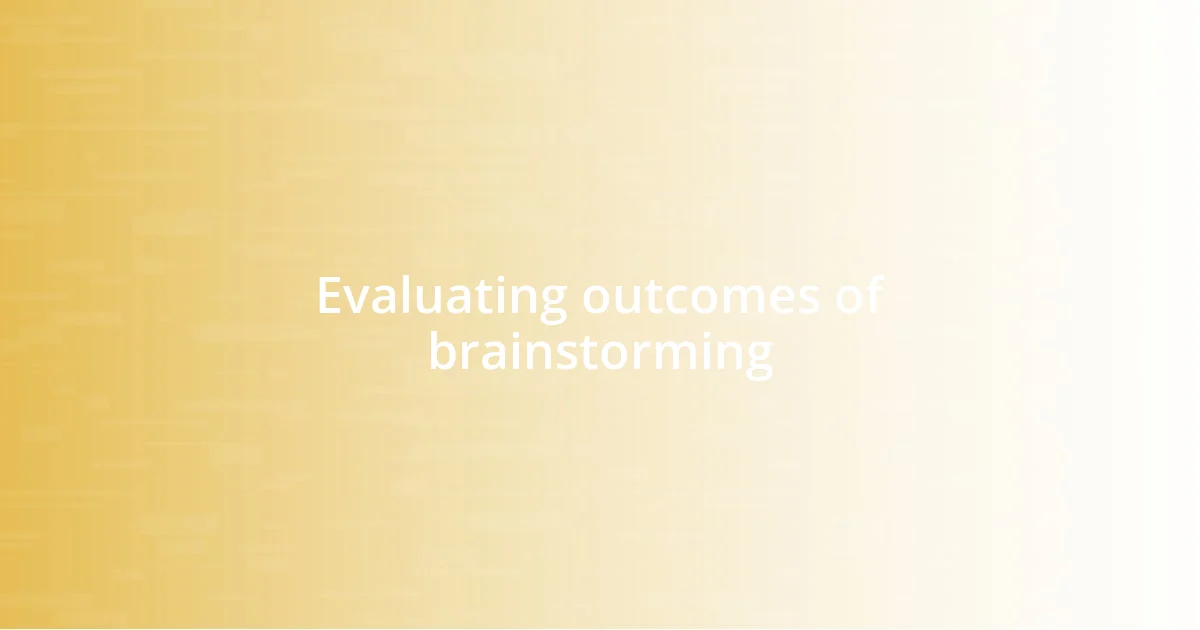
Evaluating outcomes of brainstorming
Evaluating the outcomes of brainstorming goes beyond merely tallying ideas. One of my most memorable experiences was after a particularly intense session where we generated a mountain of suggestions. As we sifted through the results, I realized that some ideas sparked deeper conversations while others faded away. It’s intriguing to assess not just the quantity, but the quality of ideas that resonate most with the group’s goals. Have you ever found that a single thought can pivot the entire direction of a project?
In my work, I’ve learned the importance of follow-up. After a brainstorming session, it’s critical to categorize and prioritize the concepts generated. There was a time we implemented a scoring system that helped us zero in on the most impactful ideas. This process was enlightening and felt like a collective victory—it transformed raw ideas into actionable steps. How often do we give enough weight to the results of these sessions? Reflecting on outcomes with the team can also uncover surprising insights, allowing us to refine our approach for the future.
Moreover, taking time to celebrate successes after implementing ideas can significantly enhance team morale. I remember a project where we returned to our original brainstorming session a few months later, celebrating how some of those ideas became successful initiatives. The gratitude in the room was palpable, and it reinforced the team’s belief in the brainstorming process. Isn’t it amazing how acknowledging outcomes not only validates our efforts but also encourages continuous innovation in future sessions?
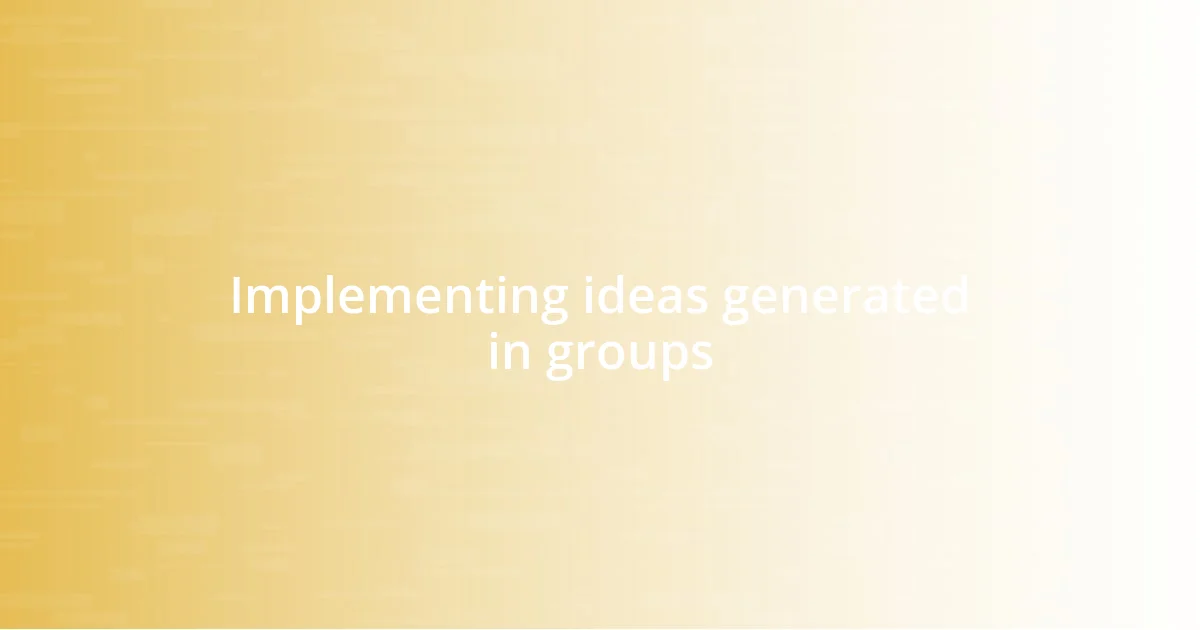
Implementing ideas generated in groups
Implementing the ideas generated in a group can be a transformative process. I recall a project where we had brainstormed dozens of potential strategies, yet it felt daunting to choose a path. To tackle this, we held a structured voting session that allowed each team member to prioritize their top three ideas. That simple act not only focused our efforts but also empowered everyone, making the implementation phase feel collaborative rather than top-down. Have you ever experienced the shift in energy that comes from shared ownership of an idea?
Another memorable moment was when we agreed to prototype the top-voted idea rapidly. This quick turnaround fostered a sense of urgency that injected enthusiasm into the team. I distinctly remember the pride that radiated from everyone when we showcased our initial prototype to stakeholders. There’s something invigorating about seeing a concept evolve from brainstormed thoughts into a tangible outcome. Isn’t it incredible how energy can shift when we watch our collective creativity take flight?
One key aspect I’ve learned is the importance of feedback post-implementation. After rolling out an idea, I initiated a feedback loop with the team. We gathered perspectives on what worked, what didn’t, and how we could improve moving forward. This practice not only refined our processes but also deepened our trust and camaraderie. When team members feel heard and valued in shaping outcomes, doesn’t that create a stronger foundation for future brainstorming sessions?















